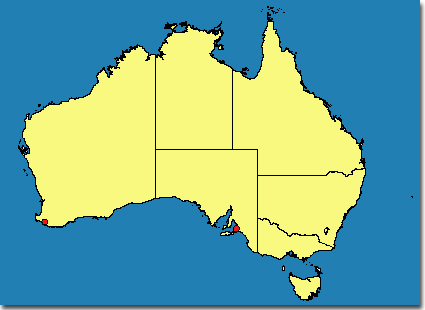 |
 |
||
|
|
|||
| Diagnosis | Encarsia ustulata Schmidt & Naumann |
|||||||||||||
| Species group | ||||||||||||||
| Distribution | ||||||||||||||
| Host | ||||||||||||||
| Comments | ||||||||||||||
| Illustrations | ||||||||||||||
| DNA | ||||||||||||||
Encarsia ustulata Schmidt & Naumann, 2001. Holotype female. South Australia, Aldinga Scrub, 50 km S of Adelaide, xiii.1986 (John S. Noyes) (ANIC). |
||||||||||||||
Diagnosis |
FemaleColourHead yellow with dark transverse band. Mesosoma yellow except pronotum, mesonotum anteriorly and axillae partly brown. Petiole brown. Metasoma predominantly brown. Antenna yellow with apex darkened (sometimes faint). Fore wing with dark band behind marginal vein. Legs yellow. MorphologyClava 2-segmented. Pedicel subequal to F1 (1.00-1.11). F1 3.29-4.00 x as long as wide, shorter than F2 (0.77-0.85) and slightly shorter to or subequal to F3 (0.87-1.10). Flagellomers with the following number of sensilla: F1: 0, F2: 1, F3: 1, F4: 2, F5: 3, F6: 3. Head with rugose surface sculpture. Mesonotum with 8 setae arranged in symmetrically, side lobes with 3 setae each. Scutellar sensilla close together, separated by a distance of about the width of a sensillum or less. Distance between anterior pair of scutellar setae distinctly smaller than between posterior pair. Fore wing 2.6-2.7 x as long as wide. Marginal fringe 0.2-0.3 x as long as wing width. Submarginal vein with 2 setae, marginal vein anteriorly with 6-7 setae. Tarsus of middle leg 5-segmented. Apical spur of midtibia longer than half the length of the corresponding basitarsus (0.60-0.70). Tergites laterally with the following number of setae: T2: 0, T3: 2, T4: 2, T5: 2, T6: 3, T7: 3. T8 with 4 setae. Ovipositor longer than middle tibia (1.11-1.20). Third valvula 0.29-0.30 x as long as second valvifer. |
|||||||||||||
Species
|
E. strenua-group. |
|||||||||||||
Distribution
|
 Click here for material examined window. |
|||||||||||||
Host |
T. vaporariorum (Westwood). |
|||||||||||||
Comments |
This species has been reared from tamarillo heavily infested with T. vaporariorum in Pemberton, Western Australia. The vast majority of these were parasitized by a Eretmocerus warrae Naumann & Schmidt (Aphelinidae) (De Barro et al., 2000). The lack of additional specimens suggests that E. ustulata may not normally parasitize T. vaporariorum.
The species is similar to E. whittieri Girault (1915: 60), but can be separated by the ovipositor which is about 1.5 x the length of the middle tibia in E. whittieri, whereas it is 1.11-1.20 x in E. ustulata. Furthermore, in E. whittieri the gastral tergites G3 and G4 have laterally only a single seta on each side, whereas there are 2 setae in E. ustulata. Encarsia whittieri is known only from the type specimen collected in New South Wales, Tweed Heads (Tweed River), by A.P. Dodd on 2 May 1914. The host of E. whittieri is not known. |
|||||||||||||
Illustrations |
|
|||||||||||||
DNA
|
Insufficient material for DNA analysis. | |||||||||||||
| © Copyright 2001, CSIRO Australia |
| [webmaster - February 2001] |
| Use of this web site and information available from it is subject to our |
| Legal Notice and Disclaimer |